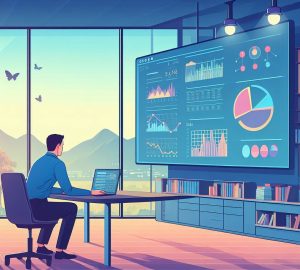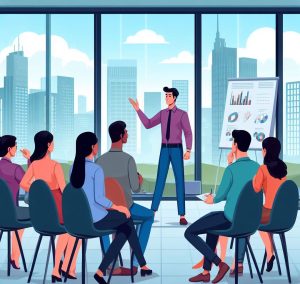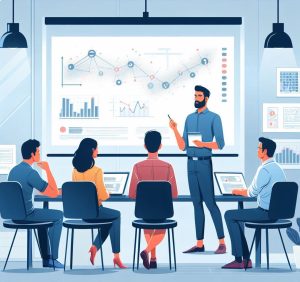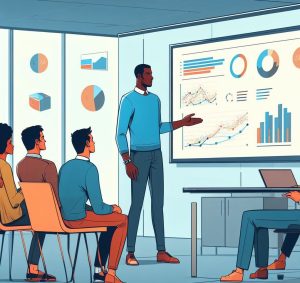What Does a Data Storyteller Do?
Data Storytellers are experts in translating data analysis into engaging, understandable stories. They help organizations effectively communicate trends, patterns, and insights from data to support decision-making.

Their tasks include:
- Interpreting and analyzing data.
- Developing engaging and insightful data stories.
- Presenting data in a visually appealing way.
- Collaborating with data analysis teams and other stakeholders to support data-driven decisions.
- Understanding the audience's needs to create relevant and effective data stories.

Job Profile of a Data Storyteller
A typical job profile of a Data Storyteller includes:
- A relevant academic background, such as data science, statistics, journalism, or a related field.
- Experience working with data and using data analysis tools.
- Strong written and verbal communication skills.
- Experience creating visually appealing presentations.
- Knowledge of and experience with data visualization tools, such as Tableau, Power BI, or R.

What tools does a Data Storyteller use?
Data Analysis Tools
Before you can tell a story with data, you first need to analyze the data. This process includes collecting, cleaning, structuring, and interpreting data. Tools like Python, R, SQL, and Excel remain essential for carrying out the initial phases of this process, but other tools like Jupyter Notebooks and Google Colab are also becoming increasingly popular for interactive analysis.
Advanced Statistical Software
For in-depth statistical analyses, tools like SPSS, SAS, and Stata are crucial. These platforms support complex analyses such as regression analysis, factor analysis, and cluster analysis. Additionally, software like Python with libraries such as Pandas, Statsmodels, and SciPy is gaining popularity due to the flexibility and scalability it offers for advanced statistical applications.
Data Visualization Tools
Data visualization is crucial for effectively communicating insights. It allows the Data Storyteller to present complex data in a simple and understandable way. Tools like Tableau, PowerBI, D3.js, and Google Charts are powerful tools for creating visually appealing and informative graphs. Furthermore, new visualization platforms like Plotly and Power BI's integration with Azure AI allow for the creation of dynamic and interactive visualizations.
Presentation Software
After data analysis and visualization are complete, it's important to present the information in an engaging and understandable way. Tools like PowerPoint, Prezi, Keynote, and Google Slides offer versatile options for visual storytelling. Additionally, more advanced presentation techniques are now available, including interactive elements and integration with visualization tools like Tableau, further enhancing the impact of presentations.
Interactive Dashboards
Interactive dashboards allow users to experiment with the data themselves. Tools like Tableau, Power BI, Looker, and QlikView offer powerful capabilities to dynamically explore and display data interactively. With the rise of cloud-based solutions and artificial intelligence, the functionality of dashboards is further expanded, for example, by automating analyses and using AI-driven insights.
Writing and Editing Tools
Well-written text is essential for supporting the data and conveying the story. Tools like Google Docs, Microsoft Word, Grammarly, and Hemingway Editor are useful tools for writing and editing these texts. Nowadays, AI-based writing tools are increasingly used to improve writing style and ensure coherence, offering suggestions for more readable and action-oriented texts.
Collaboration Tools
Collaboration tools like Slack, Trello, Asana, and Microsoft Teams are essential for coordinating tasks and sharing information within teams. Through integrations with various data analysis tools, teams can collaborate in real-time, making processes faster and more efficient. The use of digital workspaces is becoming more common for sharing visual analyses and editing datasets collaboratively within teams.
A Day in the Life of a Data Storyteller
A Data Storyteller brings data to life by applying storytelling techniques, making complex information accessible and understandable to a wide audience. An average day involves collecting and analyzing raw datasets to discover interesting patterns and insights. This is done in close collaboration with data analysts and other experts. The Data Storyteller then translates these insights into engaging stories, often supported by visual elements such as charts, infographics, and dashboards. Time is spent perfecting presentations, aligning with stakeholders, and delivering workshops or presentations. The focus is always on effectively communicating data-driven insights in a way that is relevant and engaging for the intended audience.
What does a Data Storyteller earn?
A Data Storyteller with a few years of experience can expect a salary between €4,000 and €6,000 per month, depending on experience and the type of organization. For a Data Storyteller with 3 to 5 years of experience, the salary typically ranges from €4,000 to €5,500 per month. When experience is between 5 and 10 years, the salary can rise to €6,000 to €7,000. The salary for senior Data Storytellers with more than 10 years of experience can even reach €7,500 or more, depending on the company and specific responsibilities.

Career Path and Growth Opportunities as a Data Storyteller
A career as a Data Storyteller offers many opportunities for growth. With experience and expertise, you can advance to more senior or leadership roles, such as Data Strategy Manager or Head of Data Science Communication. You can also specialize in specific industries or types of data.

Training and Certification for Data Storytellers
Continuously learning and improving your skills is essential for a successful career as a Data Storyteller. The demand for data analysis talent is growing, and there are various advanced certifications and courses available that focus on enhancing your data storytelling skills:
Data Visualization Certificate
This certification focuses on effectively visualizing data, with an emphasis on presenting complex information in a clear and engaging way for different audiences.
Data Storytelling Certificate
This course focuses on using data to create compelling and persuasive stories, making complex insights understandable for a wide audience, from technical experts to decision-makers.
Advanced Analytics Certificate
This certification focuses on mastering advanced data analysis techniques, such as machine learning and predictive analytics, enabling you to extract deeper insights from data and contribute to strategic decision-making.

Taking these courses and obtaining certifications demonstrates that you have the necessary knowledge and expertise to be successful as a Data Storyteller. With this, you can effectively contribute to data-driven decision-making within organizations and play a key role in translating data into understandable, action-oriented insights.
Networking and Industry Organizations
Industry Associations
It is also important to stay actively involved in the data storytelling community and stay up to date with the latest developments, best practices, and trends. This can be done by joining industry associations, such as the Data Visualization Society or the Storytelling with Data Community, attending conferences and seminars, and building a professional network with other Data Storytellers and professionals in the field. By staying actively involved, you not only increase your knowledge and skills, but you also enhance your visibility and career opportunities in the field.
Online
Additionally, there are numerous online forums, LinkedIn groups, and other social media platforms where Data Storytellers can share experiences, knowledge, and insights.

Impact and Social Relevance
A Data Storyteller plays a crucial role in translating complex data into understandable and engaging stories for a wide audience. In an era where data is overwhelming and ubiquitous, the Data Storyteller helps organizations and the public understand the meaning and value of this information. By visualizing and contextualizing data, they can shed light on societal issues and inspire action. Their work contributes to an informed society, where decisions are based on facts rather than gut feelings. Whether it's about climate change, healthcare, or urban development, the Data Storyteller ensures that essential information becomes accessible and comprehensible, enabling both the general public and policymakers to make informed decisions.
Case Study: The Art of Data Storytelling
Background
At BioHealth, an innovative healthcare company, datasets piled up, full of potentially valuable insights. However, conveying this data to non-specialized stakeholders proved to be a challenge, as complex statistics and data analyses were difficult to interpret for the majority of staff and external partners.
The Challenge
Presenting data in an understandable and convincing way was crucial to gaining support for data-driven decisions. There was a need for a specialist who could bridge the gap between technical data analysts and stakeholders without specific data knowledge, through effective communication and data visualization.
Action by the Data Storyteller
Tom, hired as a Data Storyteller, dove deep into the datasets and worked with data analysts to clarify key insights and messages. Using visualization tools and a narrative approach, he created powerful stories that brought the data to life and translated complex analyses into understandable and actionable insights.
Result
Thanks to Tom's ability to translate data into clear, engaging stories, BioHealth’s employees and partners were empowered to understand and support data-driven decisions. This led to more informed strategic choices, improved operational efficiency, and increased engagement in promoting a data-driven culture within the company.

Job Vacancies for Data Storytellers
View all current vacancies on DataJobs.nl here
Looking for a Data Storyteller?
For a small fee, you can easily post your job vacancies on our platform and reach our large, relevant network of data and analytics specialists. Applicants will respond directly to you, without third-party involvement.
On DataJobs.nl, we bring supply and demand in the data and analytics job market directly together—without intermediaries. You won't find job vacancies from recruitment agencies here. Visitors can view all job listings for free and apply directly without an account.
Check the options for posting job vacancies here. Have questions? Contact us!
Op zoek naar een uitdaging in data & analytics?
Bekijk hier alle actuele kansen! See vacancies- What Does a Data Storyteller Do?
- Job Profile of a Data Storyteller
- What tools does a Data Storyteller use?
- A Day in the Life of a Data Storyteller
- What does a Data Storyteller earn?
- Career Path and Growth Opportunities as a Data Storyteller
- Training and Certification for Data Storytellers
- Networking and Industry Organizations
- Impact and Social Relevance
- Case Study: The Art of Data Storytelling
- Job Vacancies for Data Storytellers
- Looking for a Data Storyteller?


